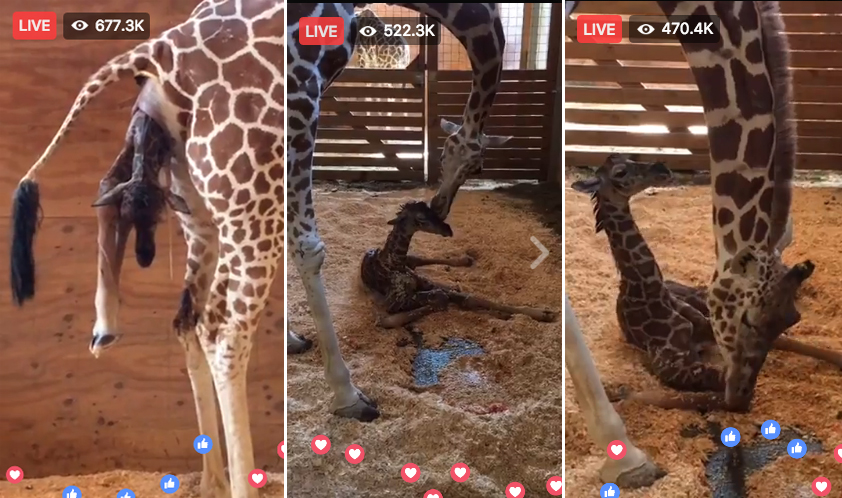Watch Live: April the Giraffe Cares for Her Calf
UPDATE (April 15): "Everybody, are you watching? IT'S HAPPENING!" At 7:29 A.M. local time, Jordan Patch, owner of Animal Adventure Park — home of April the giraffe — announced on Facebook that April had entered active labor. The baby's hooves emerged first, and the rest should shortly follow.
Here's the rundown:
9:48 a.m.: The head appears. 9:53 a.m.: The baby's head, neck and shoulders are visible. 9:54 a.m.: The baby begins to slide from April's vulva and lands on the ground, a six-foot drop! April begins to clean the new arrival. 9:56 a.m.: The calf lifts its head and begins to look around. 10:07 a.m.: Jordan Patch, Animal Adventure Park (AAP) owner, ended the AAP Facebook Live transmission, saying: "We're gonna let mom and baby do their thing for a little bit." He said that the birth went perfectly, and that the baby was already nibbling at April, looking to nurse. "As soon as we know the gender, we'll let everybody know," Patch added.
On Feb. 11, a 15-year-old expectant mother began sharing the final stage of her pregnancy with the internet, via a live video feed streaming from her pen at the Animal Adventure Park in Harpursville, New York.
Her name is April, and she is one of the park's two reticulated giraffes (Giraffa camelopardalis reticulate). Since the "Giraffe Cam" first hit YouTube, tens of thousands of viewers have flocked to see the heavily pregnant mom-to-be prepare to give birth. [Giraffe Photos: Earth's Tallest Land Mammals]
This will be April's fourth calf, and the first giraffe calf to be born at the Animal Adventure Park (AAP), representatives said on YouTube.
After the "Giraffe Cam" was installed, April could be observed standing, sitting and occasionally eating or pacing in her enclosure, with her mate, Oliver, frequently close by in the adjacent pen. At times, ripples were visible at the surface of her rounded belly, as the baby inside kicked and stretched.
Get the world’s most fascinating discoveries delivered straight to your inbox.
By Feb. 26, April "was notably less tolerant of veterinary examination," and on Feb. 27, "big baby kicks" were observed, though she was not yet in active labor, her keeper reported on the AAP's Facebook page.
In fact, signs of labor can be very hard to spot in giraffes, Jordan Patch, owner of the park, told Live Science. This adaptation — where evidence of birth stays hidden until the very end — helps protect vulnerable mothers and their newborns from predators in the wild. And once birth begins, it progresses quickly; the baby's hooves peek out first, followed closely by the snout, Patch said.
"And then within 30 to 60 minutes, the calf will be on the ground," he said.
April's keepers recently spotted telltale signs that told them delivery was likely to be happening soon.
"Her back end is quite swollen — there's discoloration of the vulva, and the muscles and ligaments in the tail region have all loosened," Patch told Live Science.
He also noted that there had been significant mammary development. Giraffes don't have an udder like cows or goats, but April's teats have filled over the last four to five days and have developed a waxy coating that acts like a plug, to keep the nutritious colostrum — a "pre-milk" liquid vital to newborns' health — from leaking out, Patch said.
"The wax on the teats is pronounced — there's no mistaking it," he added.
Giraffe mothers can become pregnant at any time during the year. They typically bear one calf at a time, carrying their young for about 15 months and then giving birth standing up, dropping the calf about 6 feet (2 meters) to the ground, according to the San Diego Zoo.
Newborn calves weigh about 150 pounds (68 kilograms) and can measure as tall as 6 feet (2 m) at the shoulder. They are able to stand upright between 5 and 20 minutes after birth, and begin suckling shortly thereafter.
Once April's calf is born, weaning could take 10 months or longer; park officials will monitor the weaning process while allowing it to occur at a "natural" pace, representatives said. After the young giraffe is eating solid food, it will be transported to another site, to participate in that park's breeding program.
The birth range that AAP initially calculated for the new arrival was from mid-January to mid-February, but viewers eager for a glimpse of the birth may still have some waiting to do, Patch warned.
"The timelines we place on these animals are from observations and data collected from other zoological societies — nature doesn't live by those constraints," Patch said. "You just need to relax and be patient."
Original article on Live Science.

Mindy Weisberger is a science journalist and author of "Rise of the Zombie Bugs: The Surprising Science of Parasitic Mind-Control" (Hopkins Press). She formerly edited for Scholastic and was a channel editor and senior writer for Live Science. She has reported on general science, covering climate change, paleontology, biology and space. Mindy studied film at Columbia University; prior to LS, she produced, wrote and directed media for the American Museum of Natural History in NYC. Her videos about dinosaurs, astrophysics, biodiversity and evolution appear in museums and science centers worldwide, earning awards such as the CINE Golden Eagle and the Communicator Award of Excellence. Her writing has also appeared in Scientific American, The Washington Post, How It Works Magazine and CNN.



